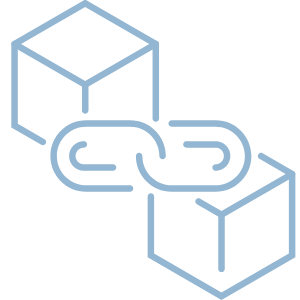Blockchain in Tax Administrations

The present comment explores some cases of concrete application of blockchain technology in Tax Administrations (TAs), and then formulates some ideas of its possible expansion in the near future, considering the advantages and disadvantages.
- SOME ADVANTAGES OF BLOCKCHAIN
Blockchain is a digital mechanism to create a digital and distributed ledger, in which two or more participants in a peer-to-peer network can exchange information and assets directly, without intermediaries. he blockchain authenticates the participants, validates that they have the assets on which they want to trade, and records the exchanges in said digital ledger, of which all participants have an updated copy and whose entries or records, which are not modifiable, they are chronologically organized and packed into blocks, encrypted, and linked to each other. Its essential elements are distribution, asymmetric encryption and pseudonymity, immutability, tokenization (secure transfers of value), and decentralization[1].
Among the advantages is its security, the decentralization of the network with smart contracts that can streamline and optimize processes, the possibility of traceability and follow the path of each product from manufacturing to its destination market, cost reduction and the transparency of transactions, speed, and efficiency that can help achieve interoperability between participants, allowing them to access the same data simultaneously.
There are three types of blockchain: public (the classic model, with open networks that allow anonymous participation, such as Bitcoin); private (with a person responsible for the chain who defines all the rules and supervises their compliance; and authorized (permission) (closed ecosystem in which each participant or node is identified and has a previously assigned role). This last type of blockchain allows the creation of organizations or groups of organizations for a specific business case.
Probably the blockchain technology that is most commonly implemented in the TAs is in an authorized mode.[2]
- EXAMPLES OF APPLICATION OF BLOCKCHAIN IN TAX ADMINISTRATIONS.
The federal tax administration of Brazil implemented a system based on blockchain, called – “bCPF”, to share data from the Registry of Taxpayers / Individuals (CPF) between tax and regulatory institutions of the three levels of government (federal, state, and municipal). The next step is the implementation of the Blockchain-based Registry of Legal Entities, the “bCNPJ”, with the same objectives. It uses an authorized blockchain based on auditable open-source software, in which only authorized institutions can participate.[3]
There are proposals for other applications of blockchains in the tax field, such as the development of specific cryptocurrencies to reduce VAT fraud in intra-community transactions within the European Union. Blockchain could solve many of the system’s weaknesses by creating a digital invoice register, which would allow tax authorities across Europe to view and verify the taxes paid when a product changes hands.[4]
Regarding the Mercosur Customs, they are connected by BConnect, a blockchain network developed by Serpro for the Federal Tax Service of Brazil. It began to be used in October 2020 to connect customs in Brazil, Argentina, Paraguay, and Uruguay. The platform aims to guarantee the authenticity and security of customs data shared between the Mercosur countries. It started by allowing the exchange of information from Authorized Economic Operators (AEO) and there is already an increase of network to comply with the exchange of information on Customs Declarations[5].
Argentina has implemented the Single Tax Registry – Federal Register (RUT), a tax simplification mechanism that allows taxpayers of Gross Income Tax to comply through the same channel with the formal requirements of tax registration and of declaration of all modifications of data, cessation of jurisdictions, partial and total cessation of activities and/or transfer of goodwill, merger, and spin-off.
The RUT, the blockchain technology that allows data to be transferred between the AFIP, the COMARB, and the adhering jurisdictions, through a very sophisticated coding system, and in a completely secure way, safeguarding the rights of taxpayers[6].
In Finland, the TA started working with banks on a blockchain system to track taxes on real estate transactions.
In Sweden, blockchain is being tested to digitalize receipts, non-resident income tax, and customs duties.
Estonia has moved a number of government services to a blockchain system, including banking, health, and business records.
Netherlands-based startup Summitto is working on a blockchain-based accounting system that tax administrations could use to combat VAT fraud.[7]
The system managed by the Chilean SII to facilitate the verification and exchange of electronic invoices for factoring, has excellent results, with a total negotiated value equivalent to a percentage of the national GDP. This whole process as a whole could benefit from the implementation of blockchain technology that would allow different actors (including sellers, buyers, and factoring companies) to leave traces of all their operations: initial offers of documents, auctions, granting of documents, contractual details, payments, and resales, among others[8].
In China, blockchain is being used to combat false invoices. The electronic invoices that use the blockchain make use of smart contracts and encrypted algorithms to guarantee the resistance of the issuance, storage, transmission, security, and the fight against the falsification of documents. The system offers complete traceability and tamper resistance, ensuring that data cannot be changed after the fact.

Through a private or public-private hybrid chain, the system acts as an intermediary between the TA, the issuer, and the receiver of the invoices, supervising the process of circulation, reimbursement, and presentation of reports. [9]
In China, electronic invoicing using blockchain was also implemented within Beijing. Its goal is to provide more transparency to taxpayers, reduce operating costs, save social resources, increase consumer convenience to save invoices, and create a healthy and fair tax environment[10].
The Tax Agency of Thailand is implementing blockchain in VAT refunds.[11]
Also on this issue, but in the private sphere, the Abu Dhabi-based telecommunications company Etisalat has launched a blockchain-based platform designed to prevent fraud in relation to commercial invoices[12].
One field of potential development is undoubtedly the use of blockchain technology for the exchange of information both internally and internationally.
Another potential field of development is that of pre-filled tax returns, where the TAs could use a database with blockchain to supply them to taxpayers, thus making the process more efficient.
Tax administrations with access to the blockchains of multinational companies could carry out real-time tax audits in the not-too-distant future.
Blockchain also looks promising as a future application area for transfer pricing. The systematization and automation of processes could provide benefits for the application, documentation, and defense of transfer pricing, especially considering both the greater complexity of transactions between companies and the greater transparency requirements. This has the potential to significantly reduce the effort and time that TAs invest in tax audits[13].
- FINAL THOUGHTS:
The potential of blockchain is enormous and will change many aspects of our lives, not only in the tax area.
The advantages of blockchain, such as transparency, efficiency, data integrity, and security, can benefit TAs in multiple ways, just as the characteristic of decentralization can improve its efficiency and its interaction between multiple actors, by offering a more equitable environment for all stakeholders.
In any case, I want to warn you that not all the processes of the TAs can be carried out more efficiently with this technology or others.
It will be necessary to analyze in each particular case considering the context of each TA the possible application and its benefits and costs.
It would seem that the potential uses of blockchain in tax administrations are mostly concentrated in processes that require the participation of more than two actors[14].
There will have different actors with different purposes, of which the TA will be one more. The implementation of smart contracts, with operations and access restricted to specific actors, together with the ability to limit access to data through cryptography techniques, will offer great opportunities to establish different cooperation ecosystems between the actors.
Likewise, Raul Zambrano has opportunely opined[15] when saying that those problems that could potentially be solved by blockchain would be those in which there is no naturally centralized point in which all transactions or actions occur or end. During the life cycle, an important number of actors intervene, and actors do not necessarily trust each other, without this meaning that they naturally distrust each other. And they do not necessarily trust, or want to trust, a centralized regulator.
These circumstances imply that we are not dealing with TA problems (and by extension taxpayers), but rather with things in which TA is one of the participants, although in some it may be a leading actor, or in other cases, the other actors may be other tax administrations
To incorporate blockchain into the TAs, among other issues we must build the operation ecosystem, the incorporation of users, the initialization of processes and integration with existing systems, and solving the persistent problems of the past in terms of data quality or the creation of a legal base that supports the new transactions.
This is because, while blockchain can ensure that third-party information is accurately collected and disseminated, the technology, as conventionally described, cannot control input errors. For this reason, it is vital to work on the quality of the “input” data, or what the technology will receive, as it is commonly said in computing if what enters is “garbage”, what comes out is “garbage.”
Therefore, it will be important to determine who is responsible for providing adequate data entries and also approvals for the accuracy of these data.
Current and emerging technologies can combat fraud by moving taxes closer to transactions in what are known as ongoing transaction controls.
It will be important that the blockchain solutions implemented by the TAs are compatible with the accounting and computer systems used by taxpayers.
I believe it is vital, on the one hand, to promote technology for its efficiency, but on the other hand, to be attentive to its governance.
I am specifically referring to avoiding possible biases with its use, always respecting the rights and guarantees of taxpayers in all areas, starting with the protection of their personal data.
Finally, I wanted to share some ideas about the incorporation of this technology in the TAs and as always I open the subject to debate.
[1]Confr. Gartner, Inc., The real business of blockchain, written by David Furlonger and Christophe Uzureau, and published in 2019 by Harvard Business Review Press, p.10. Extracted from the Smart Contracts Book by Sebastian Heredia Querro 2020.
[2]ICT as a Strategic Tool to leapfrog the Efficiency of Tax Administrations / 2020 p. 545 OPAC – CIAT
[3]ICT as a Strategic Tool to leapfrog the Efficiency of Tax Administrations / 2020 p. 38 ICT as a Strategic Tool to Enhance … OPAC – CIAT
[4]https://news.bloombergtax.com/daily-tax-report-international/eu-inches-toward-blockchain-in-fight-against-vat-fraud-1
[5]https://latam.portalerp.com/las-aduanas-del-mercosur-estan-conectadas-por-blockchain
[6]https://www.argentina.gob.ar/economia/politicatributaria/armonizacion/registrounicotributario
[7]https://news.bloombergtax.com/daily-tax-report-international/eu-inches-toward-blockchain-in-fight-against-vat-fraud-1
[8]Idem quote 2 p. 548.
[9]https://www.antilavadodedinero.com/pekin-probara-una-blockchain-platform-to-fight-the-fraudulent-bills/
[10]https://www.cripto247.com/comunidad-cripto/beijing-implementara-facturacion-blockchain-188669
[11]https://www.coindesk.com/thailand-government-trials-blockchain-in-fight-against-tax-fraud
[12]https://iclg.com/ibr/articles/16377-uae-welcomes-new-blockchain-platform
[13]https://news.bloombergtax.com/transfer-pricing/insight-blockchains-relevance-for-tax-and-transfer-pricing-purposes
[14] IDEM QUOTE 2, PAG 546.
[15]https://www.ciat.org/se-busca-problema-con-buena-presencia-y-aplicacion-con-uso-propio/
28,117 total views, 8 views today
